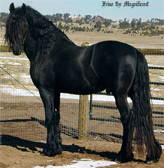Laminitis is universally hated by both horses and their owners, and when you think of your horse’s health, this condition may be one of the first on your mind. Laminitis is common because it can be triggered by a variety of factors, such as dietary changes, excessive concussion on the hoof of the horse, sickness, stress on your horse’s body or emotional stress, sugar intake, etc. The causes of laminitis are so omnipresent that they can seem overwhelming, especially when coupled with the transitionary period that spring causes in your horse’s diet. In this post, we will highlight several concrete changes you can make to help your horse avoid this dreaded condition.
Proper Diet
Likely the most common cause of laminitis is an excess of sugars in the horse’s diet. When the sunlight hits the grass, photosynthesis causes the grass to create sugars to fuel its growth. The most sugar is stored at the base of the plant, which makes overgrazed pastures a dangerous place to let your horse stay for extended periods of time. Excess sugar spikes or deficiencies are the leading causes of laminitis, so it is important to learn how to regulate your horse’s diet properly.

Another tip: If the temperature outside is cold but the sun is still shining, grass will stunt its growth but continue to produce much more sugar. This leads to oversaturation of sugars in the pastures that your horse eats from. If it is continually cold and sunny outside, take your horse inside and switch to hay. If there is no sun for several days, however, your horse should be fed grass to supplement its sugar levels.
A key vitamin that this grass contains is Vitamin E, a vital nutrient to the horse’s immune system, muscles, and nerves. Horse’s can receive this nutrient from grass, but as we’ve stated, horses cannot eat too much of the leafy greens without risking sugar excess. Vitamin E supplementation then becomes necessary for any horse dieting with hay, or on these cloudy, rainy, or dry days. Equine Medical and Surgical Associates provide complimentary veterinary consultations for your horse’s health and overall diet. We are happy to discuss how you can properly implement Health-E, the top rated vitamin E supplement on the American market. This vital nutritional supplementation can go a long way in preventing laminitis as well as aiding in its treatment.
Transition Through Winter

Many Spring laminitis cases are often due to the neglect of the hoof during the winter months. The key to avoiding Spring flair up of this painful condition is all in the routine farrier care. When a hoof’s wall overgrows, the entire weight of the horse is put onto the laminae, or the folds of tissue connecting the pedal bone to the hoof. This causes each step to exert more and more pressure on the hoof wall. A good trim evens the distribution of weight from the laminae and redistributes it to the sole, bars, frog, and hoof wall, allowing the hoof to even the load.
While many horse owners try to manage this problem, there are common mistakes that can actually do more harm than good. A common mistake is to remove too much of the sole at the toe. This can develop into a “duck foot,” or a sloping angle of the hoof caused by the separation of the hoof wall and coffin bone. Some farriers may try and thin the toe to compensate for this excess, often to the point of bleeding. This is the most common way that horses end up in the vet-hospital due to grooming habits.
Exercise

Grass is essential to a horse’s health. Wild horses rely on this vital, nutrient-rich food to survive, and the domesticated pasture horses do not live in the same environment that forces them to run from predators or constantly be on the move to find more food. Horses produce stomach acids constantly to digest the uptake of grass, hay, and their other foods. To do this, they are designed to nearly always be foraging. Trying to alleviate laminitis by reducing your horse’s food intake can cause these stomach acids to flow into the horse’s hindgut. Exercise is the best way to regulate the calories from the intake of grass. Ride your horse often, give it ample room to wander, and keep your horse active by spacing its food supplies throughout the pastures.
Remember these tips to help prevent this risky disease, and also remember the importance and help of vitamin E in your horse’s diet. Coupled with our other products, your horse’s hooves will be happy and healthy to ride into the summer months. Make sure your horse puts its best foot forward this summer with Dr. Reily, our lead veterinarian’s free consultations. Visit our contact information page to schedule a consultation or if you have any questions regarding our products, insulin resistant horses, heaved/COPD horses, mare problems, or other general questions.





; ?>/wp-content/themes/twentyten/img/NMImacLogo_150.jpg)






